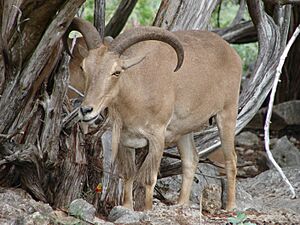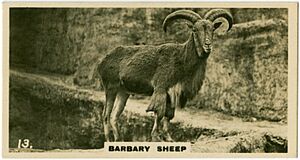Barbary sheep facts for kids
Quick facts for kids Barbary sheep |
|
|---|---|
 |
|
| Conservation status | |
| Scientific classification | |
| Subspecies | |
|
A. l. angusi Rothschild, 1921 |
|
| Synonyms | |
|
The Barbary sheep (also called aoudad) is a wild animal that looks a bit like a goat and a sheep. It lives in the rocky mountains of North Africa. It's the only type of animal in its group, called Ammotragus.
There are six different kinds, or subspecies, of Barbary sheep. While they are rare in their home country, people have brought them to places like North America and southern Europe. Sometimes, they are also called waddan, arwi, or even mouflon.
Contents
All About Barbary Sheep
Barbary sheep are pretty big animals. They stand about 75 to 110 cm (2 ft 6 in to 3 ft 7 in) tall at the shoulder. They can be around 1.5 m (5 ft) long and weigh from 30 to 145 kg (66 to 320 lb).
Their fur is sandy-brown, but it gets darker as they get older. Their belly is a bit lighter, and they have a darker line along their back. Males have shaggy hair on their throat that goes down to their chest. Both males and females have impressive horns. These horns are shaped like a triangle and curve outwards, then backwards, then inwards. They can grow to be longer than 76 cm (30 in)! The horns are mostly smooth, but you can see small wrinkles near the base as the animal gets older.
Where Barbary Sheep Live
Their Natural Home
Barbary sheep originally come from North Africa. They live in the rocky areas around the Sahara Desert. You can find them in countries like Algeria, Egypt, Libya, Morocco, and Tunisia. They also live in parts of Chad, Mali, Mauritania, Niger, and Western Sahara.
Sadly, the number of Barbary sheep in their natural home is going down. This is because of hunting and because their homes are being destroyed.
New Homes Around the World

Barbary sheep have been brought to new places, like southeastern Spain and the southwestern United States.
In Spain, they were brought in 1970 for hunting. They quickly spread to new areas. Now, you can find them in many provinces, including Alicante and Murcia. They can sometimes compete with other native animals for food. They have also spread to La Palma in the Canary Islands. Here, they are a big threat to the unique plants that grow only on that island. Barbary sheep have also been introduced to Croatia.
Even though they are not in Australia yet, people in Queensland consider them a potential pest. This means they could cause problems if they ever establish themselves there.
Barbary Sheep Family Tree
The Barbary sheep, A. lervia, is the only species in its group, called Ammotragus. Some scientists think this group should be part of the goat group (Capra) or the sheep group (Ovis).
There are six different kinds of Barbary sheep, called subspecies. They live in different parts of North Africa:
- A. l. lervia (Pallas, 1777) – This one is vulnerable.
- A. l. ornata (I. Geoffroy Saint-Hilaire, 1827) – Also known as the Egyptian Barbary sheep. It was thought to be extinct in the wild, but some have been found in Egypt's eastern desert.
- A. l. sahariensis (Rothschild, 1913) – This one is vulnerable.
- A. l. blainei (Rothschild, 1913) – This one is vulnerable.
- A. l. angusi (Rothschild, 1921) – This one is vulnerable.
- A. l. fassini (Lepri, 1930) – This one is vulnerable.
How They Live
Barbary sheep live in dry, mountainous areas. They eat grasses, bushes, and lichens. They can get all the water they need from their food. But if there's water available, they will drink it and even roll around in it!
They are most active in the early morning and late afternoon. They rest during the hottest parts of the day. Barbary sheep are very good at jumping. They can jump over 2 metres (7 ft) from a standing start! They are well-suited to their home, which has steep, rocky mountains and deep canyons. When they sense danger, they usually run uphill to escape. They move around a lot, constantly traveling through mountain ranges.
In the past, their main hunters in North Africa were big cats like the Barbary leopard and Barbary lion. Today, humans and wild dogs are their biggest threats. Also, too many domestic animals eating the same plants and dry weather (drought) threaten their populations.
What's in a Name?
The scientific name for the Barbary sheep is Ammotragus lervia.
- The word Ammotragus comes from ancient Greek. Ammos means "sand," which describes their sandy-colored fur. Tragos means "goat."
- The word Lervia comes from an old description of wild sheep in North Africa, called "lerwee."
In Spain, these sheep are called arruis. This name comes from the Berber word arrwis. The Spanish Legion even used the Barbary sheep as a mascot for a while!
The name Aoudad is what the Berbers, who live in North Africa, call this sheep. They also call it arui and waddan (in Libya).
Images for kids
-
Barbary sheep at the Wildlife Ranch in San Antonio
-
Barbary sheep at Tierpark Hagenbeck, Hamburg, Germany
-
Ewes and a juvenile at Zoologischer Garten, Berlin, Germany
-
Skeleton of a Barbary sheep (Museum of Osteology)
-
Captive Barbary sheep Safari West Santa Rosa, California














